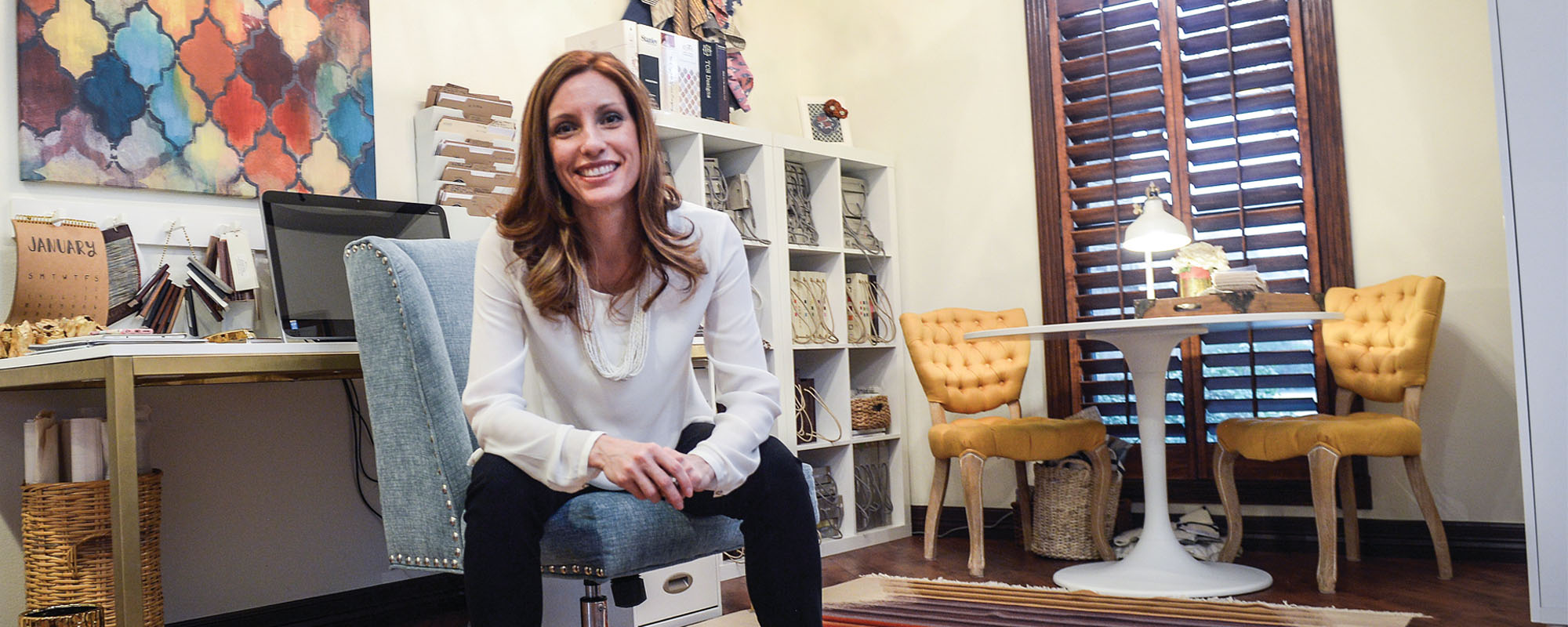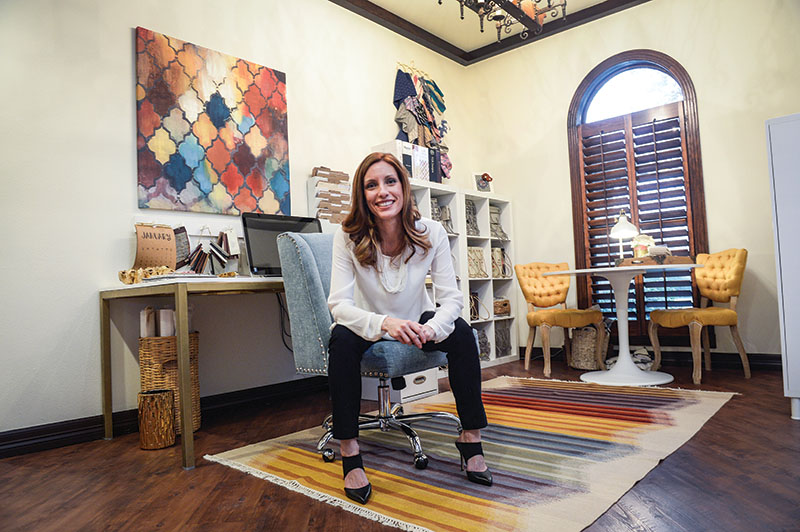Bright samples of textured carpet, easily dismissed by passing cars and the occasional dog walker, stopped Kara Gordon ’00 in her tracks.
The carpet sample book was positioned peeking over the rim of the residential trash bin—another’s trash that would soon become Gordon’s treasure. On a routine jog, the teenager eagerly pilfered the sample book, walked it home and excitedly showed her family the array of styles inside.
“I carried it all the way home and when I got there yelled, ‘Mom, look what I found!’” Gordon recalled in January while standing in the Grapevine home of her interior design client, Lisa Austin. “Mom replied, ‘Carpet samples?’ And I said, ‘Isn’t it amazing? There’s one in every color.’”
The find stoked Gordon’s already-burning passion for interior design, leading her to apply to SFA and enroll in its interior design program.
Emigrating from the bustle of north Houston, Gordon began attending SFA in 1996.
“I did take a detour,” she admitted. “I missed my family and then-boyfriend. So, I came home after my first semester at SFA. My grades were good, but I missed everyone and wasn’t ready to be away. I went back home for about a year, attended junior college and then headed back to SFA.”
Inclusive of the detour, Gordon still managed to finish the interior design program with a minor in business in four and a half years.
While standing in her design studio in her Bedford home, Gordon fanned through photos of her time in college. She pointed and laughed at a picture of herself — her hair pulled back in a classic ’90s Scrunchie — eating popcorn on her Steen Hall dormitory bed with reading materials splayed out in front of her.
Flipping further, she sees a photo of roommate Amanda Johnson and herself. Johnson remained in Nacogdoches to establish and serve as the director of Helping House, a private school for children with autism.
“I still keep in touch with professors and a few of my classmates,” Gordon said. “I was always pretty studious. I would go to class and was there to learn.”
When asked about stories of her time at SFA, one in particular came to mind.
“The professors taught us mixed media and how to draw a room based on a picture from a magazine,” she explained. “I went through the entire process, and it was time to turn it in. I even pulled an all-nighter making sure every detail was covered.”
Gordon excelled in her major and kept a stable 4.0 GPA.
“Well, I received my project back, and I made a 95. I looked on the back, and the professor noted that I forgot to color in the pillow,” Gordon smiled, rolling her eyes. “I brought it home and colored in the pillow. Then, I had it framed.”
Fond memories of SFA abound, including Associate Professor Sally Ann Swearingen’s daily routine of entering the classroom and proclaiming, “Every good designer carries a what? A tape measure!”
“Kara’s always been really outgoing and very creative,” Swearingen said. “She’s always been a self-starter. She has even Skyped in for a couple of interior design classes so students can see what an interior designer graduate is doing. It’s great she remains involved with SFA.”
Fresh out of Lumberjack country, Gordon landed a position in January 2001 at Houston-based design firm Kathy Andrews Interiors, where she had interned during college. She served in a designer position for almost 18 months before moving to Wisenbaker Builder Services in Houston. Then, wedding bells collided with her professional career when she married Anthony Gordon.
“Soon into our marriage, my stepson Stayton came to live with us,” she explained. “He was living with us full time, and my travel and work schedules weren’t what was best for him. That was when we kind of put the brakes on interior design.”
Gordon spent nine years teaching elementary school, which allowed her to keep a more routine schedule. It wasn’t until the adoption of their son, Jake, and her switch to being a full-time, stay-at-home mom that the dust shook loose on her interior design pursuit. However, wanting to return to interior design and needing a job with flexibility were in conflict.
“So, I started my company,” she said.
Sleek to Chic Interiors launched in a Dallas/Fort Worth suburb in 2013. Today, Gordon often finds herself juggling eight to 10 clients when six to eight is the designing norm for her company’s size. Of course, industry demand varies, but word of her work has spread to the point that she commonly has a four- to six-week client waiting list.
“I’ve had to learn how to refine my process,” Gordon said. “You want to come off as a professional with a buttoned-up procedure, and I will say that’s where I was not strong in the beginning, because I had literally been out of the design field for 10 years and was a stay-at-home, sleep-deprived mom. However, I always try to keep my interactions with my clients and vendors cheerful and upbeat.”
That pleasant attitude was a relief to clients like Austin, who contacted Gordon looking to redo three spaces in her home.
“Seeking an interior designer is scary because you don’t know what to expect,” Austin said while standing in the redesigned foyer of her Grapevine home. “I didn’t know if she was out of my budget or what to expect because I’ve never done anything like this before. But thankfully, Kara came in, I told her my budget, and she made it work.”
Slowly and year by year, Gordon stepped her work up a notch, electing in 2014 to put Jake in a Mother’s Day Out program two days a week for a few hours. The freed-up time expanded her workload immensely, allowing for in-person consultations and the resources to primp her portfolio for publication on Houzz and other design outlets.
“SFA did a really good job of preparing me for this field because there’s a whole course on the business side of it,” Gordon said. “There are classes on lighting, art history, art appreciation, so nothing really shocked me after entering the design world. I’m not saying I know everything, and every day I learn something new — picking up on what I could have done or should have done better. I’m constantly growing.”
Sleek to Chic Interiors continues to develop daily, and Gordon’s hope for her company’s future is both detailed and broad. She understands it will grow fluidly and on its own time, but she also has detailed hopes of her own—namely, to procure an office, preferably brick-walled in the historic area of Bedford. She envisions the building’s second story serving as a design studio and the first story as a store to sell furnishings and upholstery, as well as draperies and accessories.



